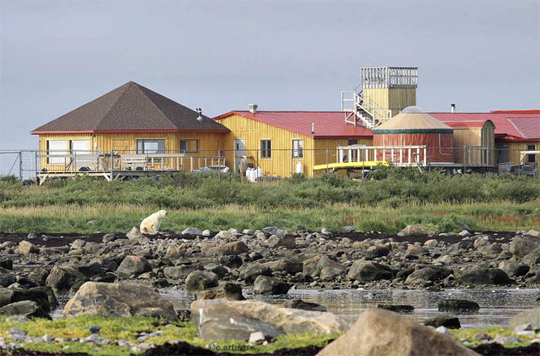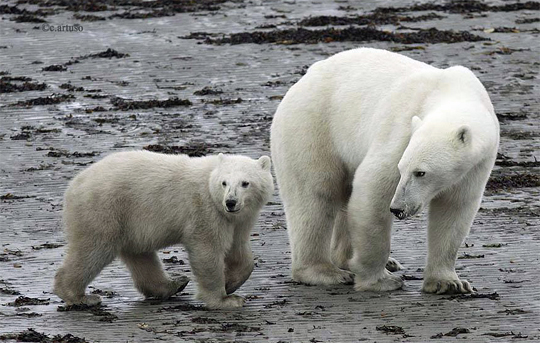Guest Post and Photos by Christian Artuso, PhD
Bird Studies Canada – Manitoba Program Manager
Seal River Heritage Lodge lies 60 km north of Churchill, right on the Hudson Bay coast. Below is a view of this superb lodge… oh yeah and a big furry white thing.
This is arguably the best place in the world to watch polar bears, like the mother and cub in the photo below, and these massive animals are certainly the biggest draw for most visitors, along with the beluga whales.
Nonetheless, along with the big mammals, there are many opportunities to view other fascinating wildlife around Seal River, and the birdwatching is excellent. This area, for example, represents the southernmost range limit for certain Arctic species like the Arctic ground-squirrel below, famously known as “Sik-Sik”. These fascinating animals don’t occur south of Seal River and hence are not found in Churchill, but they are very common around Seal River Heritage Lodge.
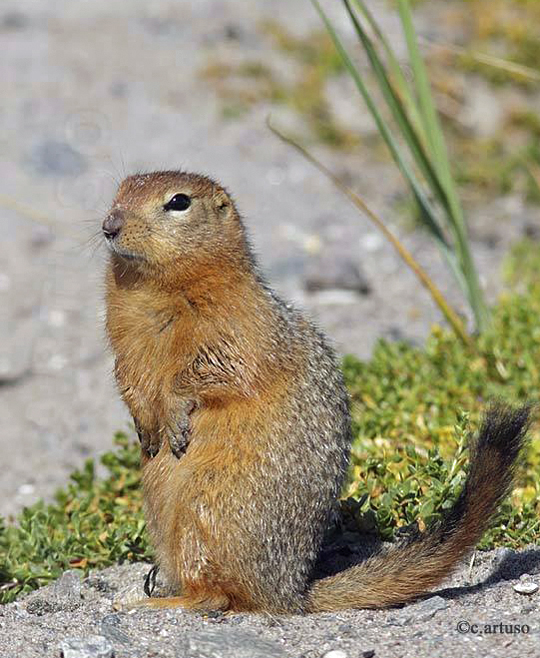
Arctic ground squirrels, commonly referred to as “Sik-Siks” are abundant around the Lodge.
Seal River Heritage Lodge is further from the trees than Nanuk Polar Bear Lodge, and most of the birding is therefore along the coastal strip. For most birders, having dinner in the main dining room and watching the tide roll in, pushing massive flocks of waterfowl and shorebirds to within easy viewing distance, along with the accompaniment of passing raptors and jaegers and other northern specialties, is the main attraction.
Nonetheless it is well worth going slightly inland towards the treeline transition for excellent birding, with a whole host of specialties. Rocky peat land such as that in the first photo below taken just west of the Lodge, is breeding habitat for the beautiful Smith’s Longspur (second photo below). This area is one of only a few places where you can witness this avian gem on its breeding grounds in spectacular breeding plumage.
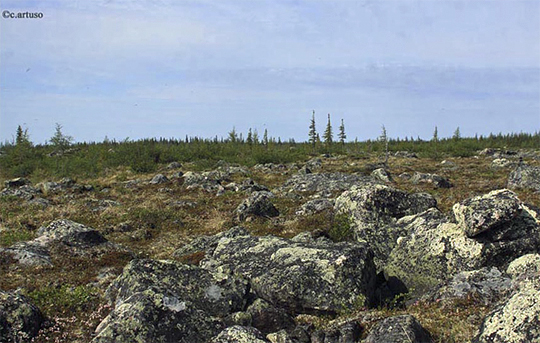
Treeline transition: Excellent birding territory!
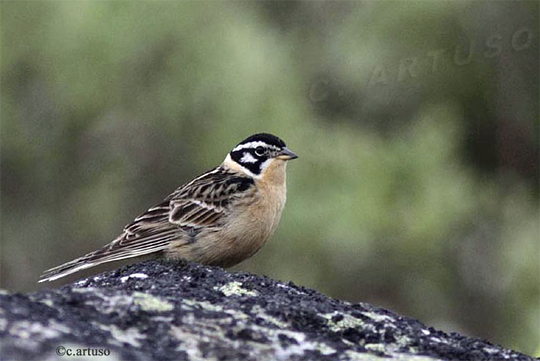
Rocky peat land is prime habitat for Smith’s Longspur.
The treeline transition is also the best place to find the superb Harris’s Sparrow (North America’s largest sparrow and always highly sought after by visiting birders).
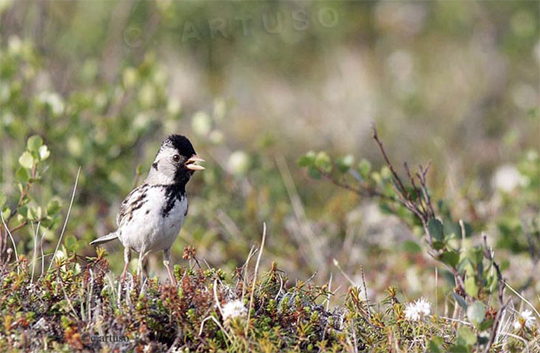
The treeline transition is the perfect place to find Harris’s Sparrow.
Birding around the small lakes near the Lodge is sure to produce many waterbirds, shorebirds and the thrill of seeing the northern loons up close and personal. The first photo below shows a Pacific Loon with her chick and the second photo shows a Red-throated Loon (both breed locally).
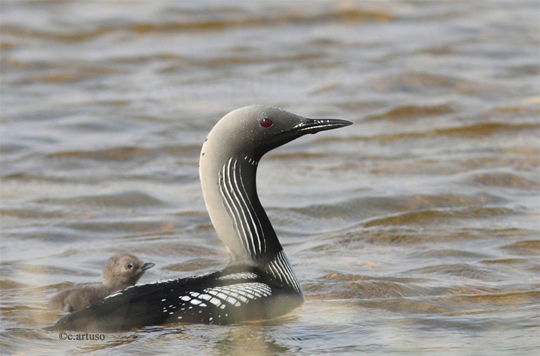
Pacific Loon with chick.
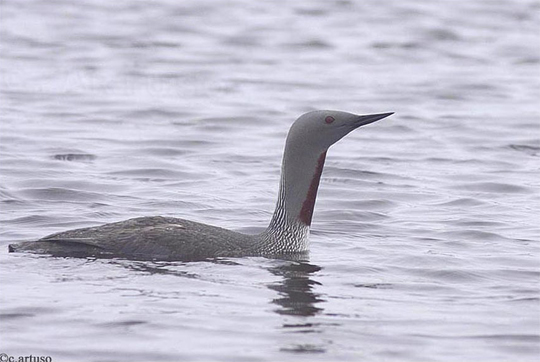
Red-throated Loon.
Another northern species with great appeal for visiting birders is the Willow Ptarmigan. They breed near the Lodge and are usually fairly easy to find, although many will leave the area in fall (in late fall Rock Ptarmigan move down into this area from further north). The first photo below shows a male Willow Ptarmigan displaying to a female and the second photo shows a young chick.
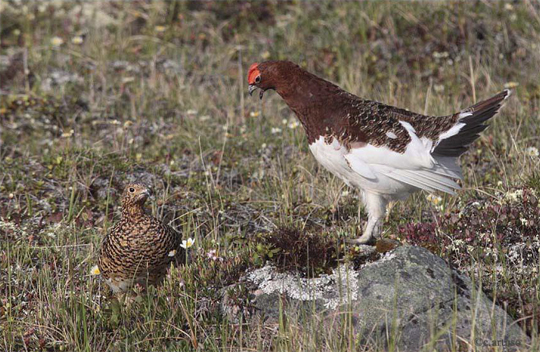
Willow Ptarmigan displaying to a female.
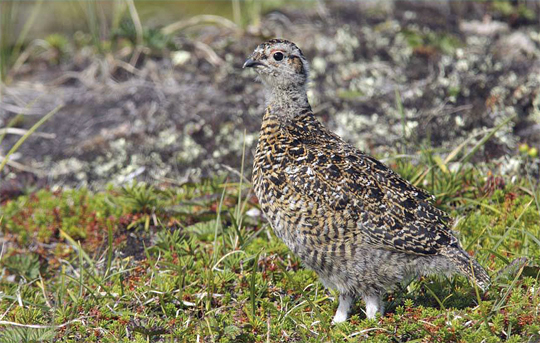
Willow Ptarmigan chick.
Short-eared Owls also breed on the open peatland here and are sometimes seen from the Lodge. With considerable luck, it is possible to find other species of owls here, such as the juvenile Northern Hawk Owl (you’ll need to walk back to the trees to find this species). Other owls are few and far between, although Snowy Owls are possible, especially in late fall.
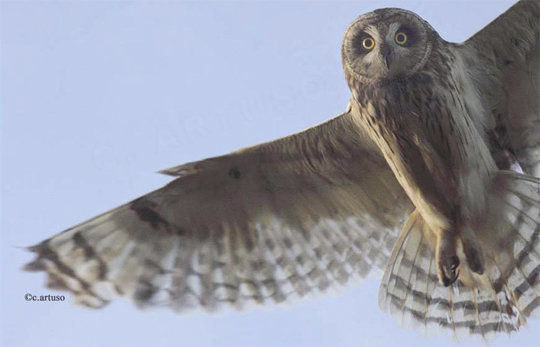
Short-eared Owl.
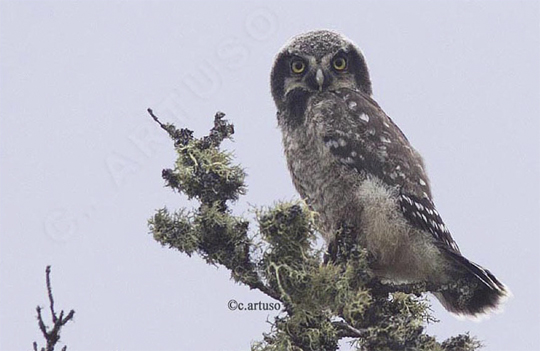
Northern Hawk Owl.
Most of your birding will occur close to the coast, where the waterfowl and shorebirds congregate. If you enjoy the spectacle of massive flocks of waterfowl such as the Snow Geese shown below, you’ll love the Seal River area.
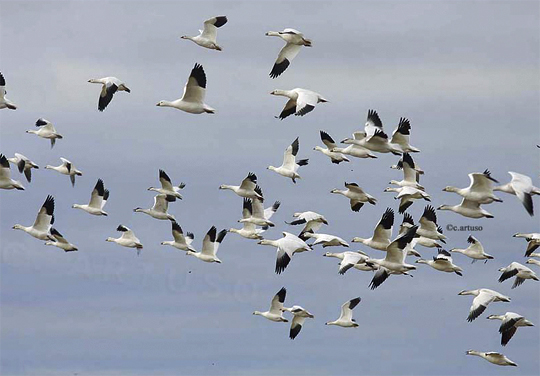
Snow geese at Seal River.
Common Eider breed here and also occur in large flocks in the fall. All three species of scoter also occur. The photo below shows White-winged Scoter and Common Eider.
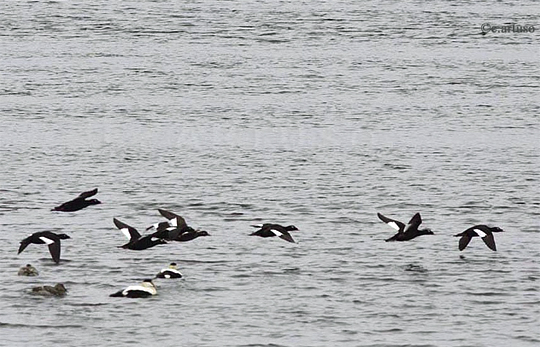
White-winged Scoter and Common Eider
In the fall, flocks of Brant move along the western coast of Hudson Bay. This species is rare anywhere else in Manitoba.

Brants over Hudson Bay.
Although all three species of jaeger have been recorded in the Seal River area, only the Parasitic Jaeger is regularly occurring. The jaeger show is always a special treat as they perform extraordinarily acrobatic flight maneuvers in order to steal food from other birds such as gulls and terns.
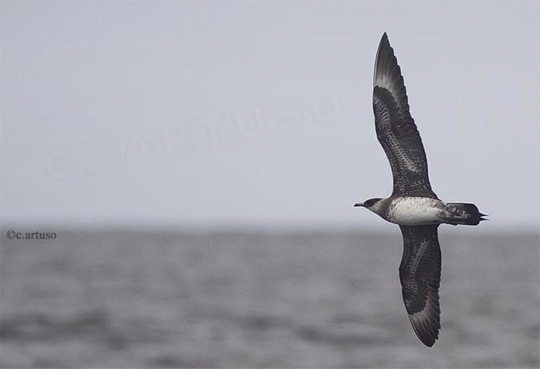
Parasitic Jaeger. A regular at Seal River.
The Lodge offers truly superb shorebirding. In July, local breeding species don their breeding colours and may be observed with downy young. By late July the migration is already underway and the flocks start to build. If you hit the tide right, the mudflats can be just teeming with shorebirds. One of the big attractions is the magnificent Hudsonian Godwit. The first photo below shows a Godwit in breeding plumage and the second shows a juvenile feeding on worms in the Hudson Bay mud.

The magnificent Hudsonian Godwit.
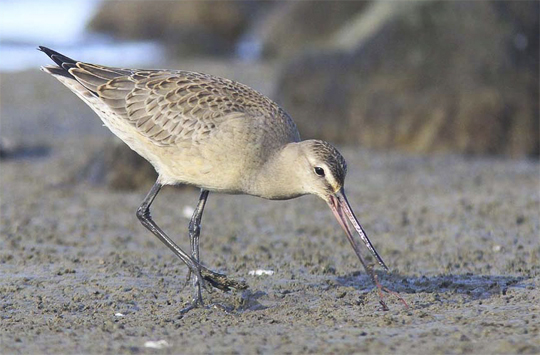
Breakfast time!
A July visit to the area offers a chance to see shorebirds breeding, including observing downy young and juvenal plumages. Below a recently hatched Semipalmated Plover chick crosses the tundra (first photo) and eventually finds shelter underneath a parent along with other siblings (second photo).
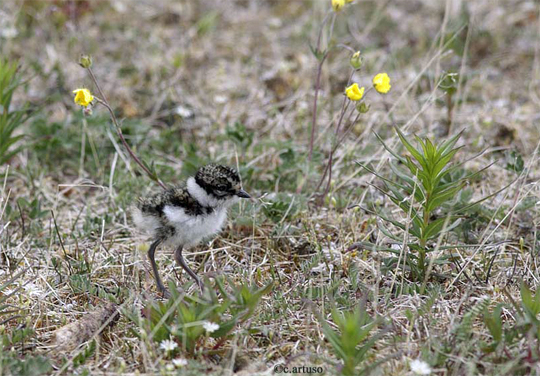
Recently hatched Semipalmated Plover chick.
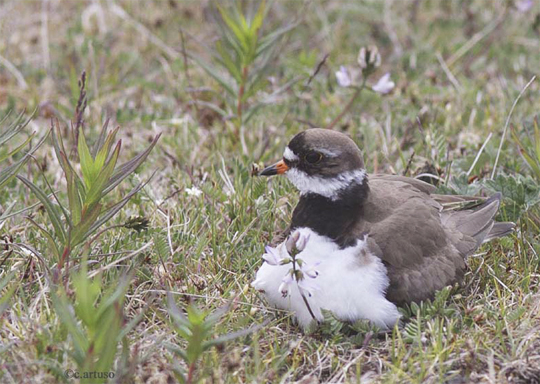
Semipalmated Plover. There are chicks under there!
The next two photos show another local breeding shorebird, the Dunlin, in full breeding colours (first photo) and in juvenal plumage (second photo).

Dunlin in breeding plumage.
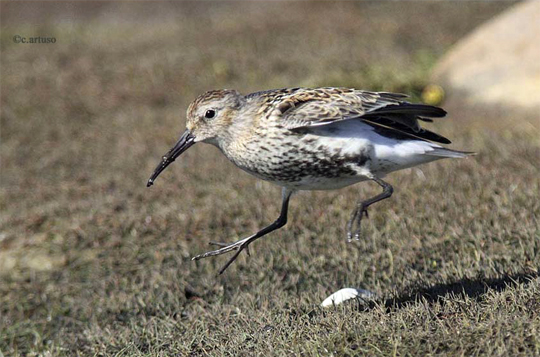
Juvenile Dunlin hopping across tundra.
Shorebirding in late July and August in the Seal River area is all about finding the flocks feeding on the mudflats. Shorebirds gather here in the tens of thousands to feed in the very productive inter-tidal zone. This is a truly fantastic location to wait on a boulder and photograph shorebirds. It allows you to observe quietly in close proximity to the birds and to witness an array of fascinating behaviours.
Most of the shorebirds here are feeding on the high quantity of worms and other invertebrates available in the inter-tidal mud, as shown in the photo below of a juvenile American Golden-Plover pulling a worm, and again by a Pectoral Sandpiper that has also found a tasty morsel.
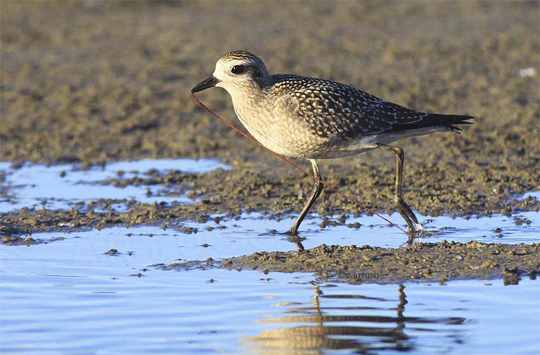
American Golden-Plover pulling a worm.
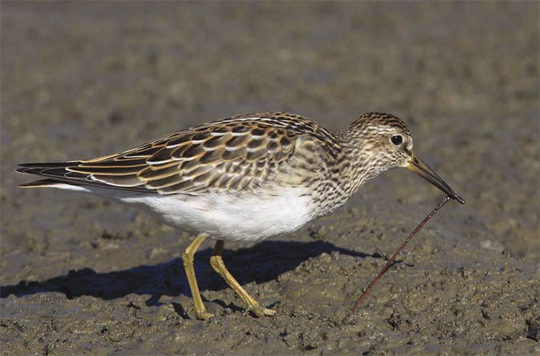
This Pectoral Sandpiper isn’t missing breakfast either!
Shorebirds are typically less shy than waterfowl, and sitting quietly in areas where the shorebirds are feeding can allow for fantastic close-up photos, such as this portrait of a Pectoral Sandpiper that walked to within a foot of me as I was conducting shorebird counts.
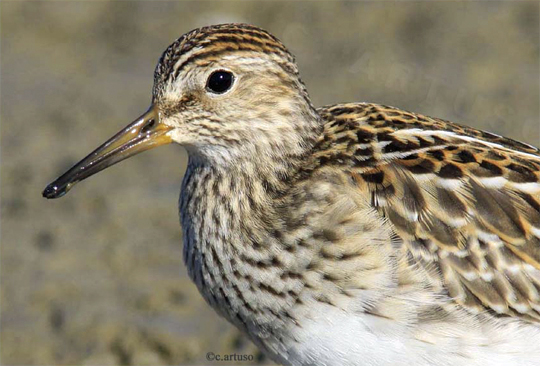
Pectoral Sandpiper close-up.
In addition to foraging behaviour, you can also observe aggressive interactions, responses to predators, and preening and bathing, as demonstrated below by a juvenile White-rumped Sandpiper.
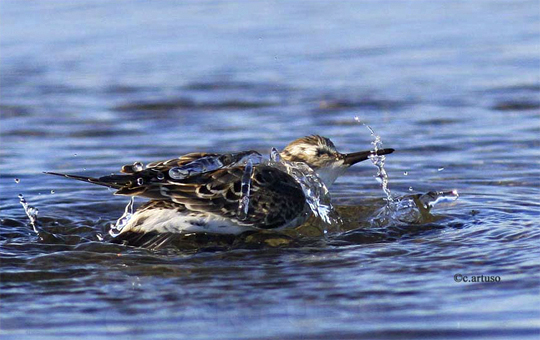
White-rumped Sandpiper enjoys a bath.
In this next photo, a juvenile Baird’s Sandpiper stretches in preparation for flight away from the busy mud flat.
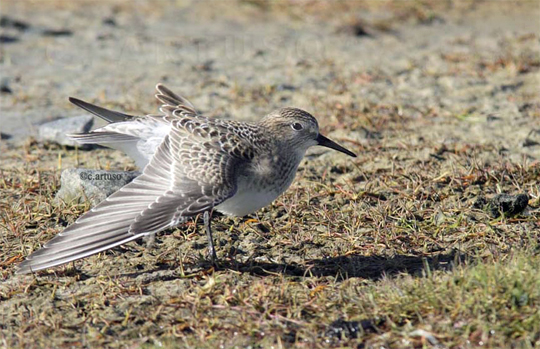
Baird’s Sandpiper juvenile prepares to take flight.
There are also shorebirds a little further inland on the coastal flats that are grazed by Canada Geese and Snow Geese. In late July, August and early September, this is the best place to look for one of the avian stars of fall birding here — the magnificent Buff-breasted Sandpiper. They are masters of camouflage however, as you will note from the photo below.
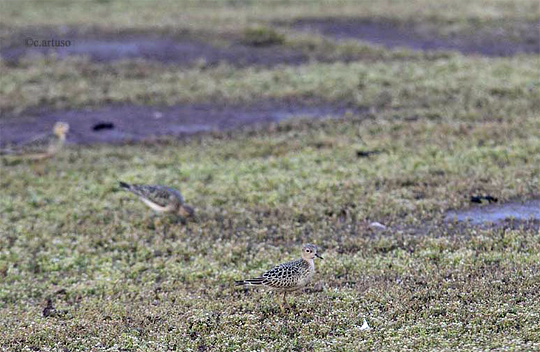
Buff-breasted Sandpipers. Camouflage experts!
If you spotted three Buff-breasted Sandpipers in the above photo, well done! If you spotted any less, go back and take a second look. The two photos below give you a closer look at these beauties!
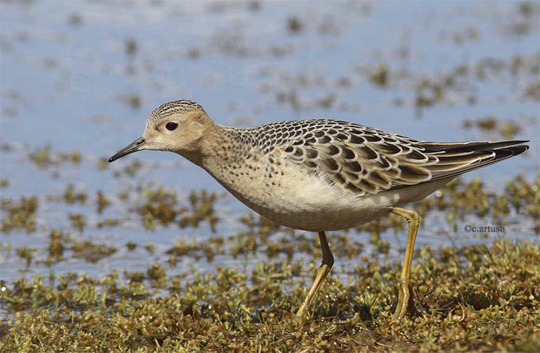
Buff-breasted Sandpiper poses for the camera.
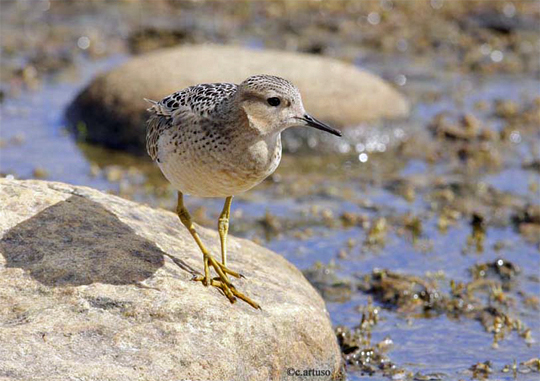
As did this one!
Other species that forage on these flats include American Golden-Plover, Lapland Longspur and Horned Lark, as shown in the photo below.
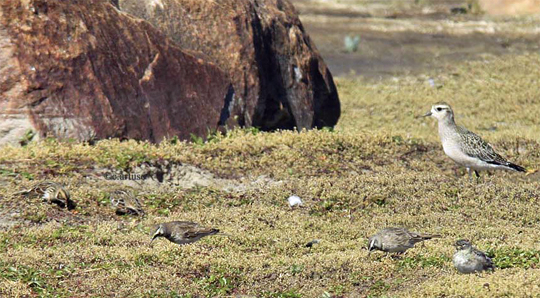
Lapland Longspur, Horned Lark and American Golden-Plover on the flats.
Below is a close-up look at one of the Lapland Longspurs in fall plumage. July is the time to see Lapland Longspurs in their magnificent breeding colours, but in August and September there are flocks of thousands near the Lodge (Smith’s Longspurs depart earlier than Lapland Longspurs).
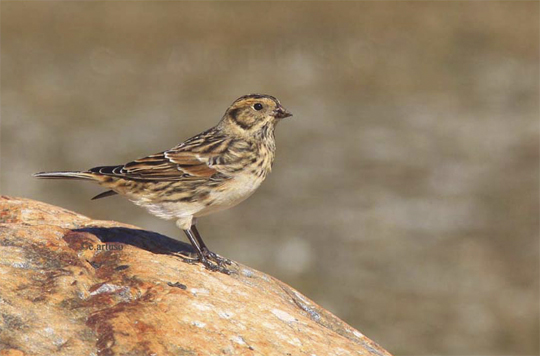
Lapland Longspur in fall plumage.
And of course, there are still a variety of northern songbirds to observe, even in the fall here. Below an American Pipit that has already moulted out of its pink breeding plumage interacts with a begging youngster.
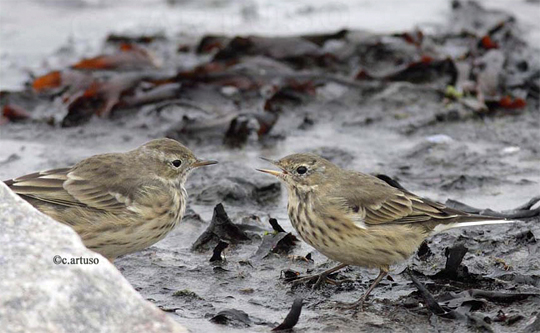
American Pipit interacts with a begging youngster.
Amongst several warbler species present, the Northern Waterthrush is a common breeder in the willows around the Lodge. In August I managed to photograph the individual below foraging on rocks in the bay near the Lodge, offering an unusually clear view of this often skulking species.
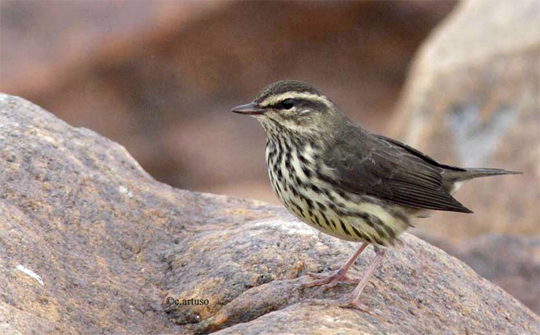
Northern Waterthrush foraging on the rocks.
The birds pictured here represent just a small handful of the many species found in the Seal River area. Diversity is very high in the summer and you might record over 100 species on a trip if you encompassed various habitat types. Especially if you were present during the migration, when the high Arctic shorebirds join the local breeders.
Fewer species can be seen in the fall, but that is nonetheless a superb time to watch the spectacle of massive migratory flocks, or to search for rarities, and, of course, to view polar bears and other amazing northern wildlife.
For more information and photos from Christian Artuso, please visit his Web site at http://artusophotos.com. You can also read Christian’s photo essays on his wildlife blog at http://artusobirds.blogspot.com.

